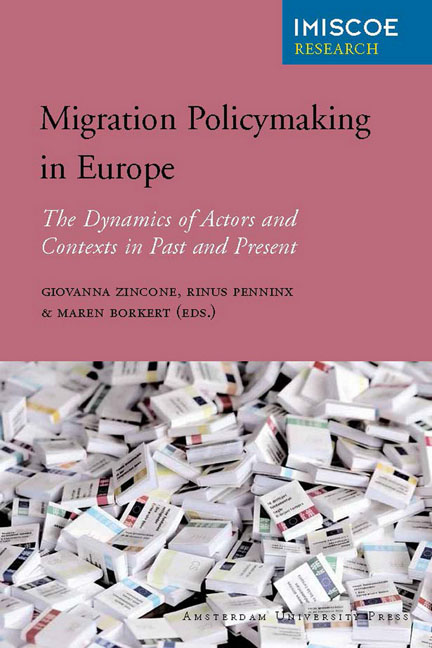Book contents
- Frontmatter
- Contents
- Policymaking in the Field of Migration and Integration in Europe: An Introduction
- Part I Post-War Migration Countries
- Part II Mediterranean Migration Countries
- Part III Eastern European Countries
- Conclusion: Comparing the Making of Migration Policies
- List of Contributors
- Other IMISCOE Titles
Policymaking in the Field of Migration and Integration in Europe: An Introduction
Published online by Cambridge University Press: 20 January 2021
- Frontmatter
- Contents
- Policymaking in the Field of Migration and Integration in Europe: An Introduction
- Part I Post-War Migration Countries
- Part II Mediterranean Migration Countries
- Part III Eastern European Countries
- Conclusion: Comparing the Making of Migration Policies
- List of Contributors
- Other IMISCOE Titles
Summary
International migration movements are often explained from an economic perspective. To do so, scholars may refer to the real or perceived differences in wage and employment opportunities between countries that cause ‘flows’ of labour and capital (Harris & Todaro 1970; Lee 1969; Piore 1979; Ravenstein 1885; Stark 1981, 1991; Stark & Levhari 1982). Structural forces such as unequal access to resources and power (Frank 1966; Massey 1989; Wallerstein 1974) must also be taken into account, along with migrant networks (Kritz et al. 1992; Mabogunje 1970; Portes & Böröcz 1987) and other constraining factors. When it comes to international migration, the state becomes an undeniably significant actor that may influence the push-and-pull factor balance of migration itself, as well as the process of settlement that may or may not follow it (Zolberg 1981, 1989).
In Europe, migration has been an important factor of change and development for a very long time (Bade et al. 2007; Moch 1992). In this sense, the growth of migration and immigrant communities during the last decades represents a clear continuity (although it is seldom perceived as such). But there have also been significant changes in recent times, both in term of the characteristics of migration movements themselves and of state efforts to regulate them. Let us summarise these two elements.
Changing migration patterns in Europe
The first change regards that of migration movements and their directions. Europe was predominantly a source continent for emigrants for more than a century, roughly between 1850 and 1950. This situation changed after the 1960s. Emigration decreased and immigration became dominant. Between 1985 and 2000, the European continent experienced a steep increase of resident immigrants, from an estimated 23 million in 1985 (United Nations 1998: 1) to more than 56 million or 7.7 per cent of the total European population in 2000 (IOM 2003: 29).
Apart from its scale, the geography of immigration also changed significantly. The origin of migrants in Europe up until the 1980s may, for simplicity's sake, be grouped under three headings: a) migration with a colonial background that connected European countries to their former colonies; b) labour migration that connected European recruiting countries to a number of selected recruitment countries; and c) refugee migration that was strongly dominated by those moving from Eastern Europe to Western Europe (i.e. displaced persons after WWII and refugees from East to West during the Cold War).
- Type
- Chapter
- Information
- Migration Policymaking in EuropeThe Dynamics of Actors and Contexts in Past and Present, pp. 7 - 18Publisher: Amsterdam University PressPrint publication year: 2012
- 1
- Cited by



